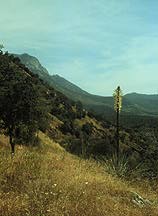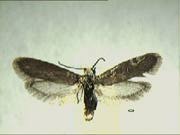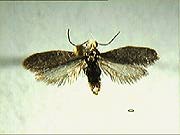Prodoxus aenescens
Olle PellmyrAdult Characteristics
Wing expanse 9-15 mm. Forewing uniformly brownish gray, with a somewhat bronzy luster. Populations in the southern part of the range are somewhat lighter. Hindwings of the same color, but lightly scaled.
Comparison with Similar Species
Prodoxus cinereus, with which it coexists in part of its range, is often somewhat lighter, but they can only be reliably told apart through inspection of the genitalia. In the male, the valva of aenescens is narrow and it has a rounder outer edge. In the female, the ovipositor has a prominent arched, dorsal ridge that terminates at the ovipositor shaft. In the larva, cinereus have two ventral hooks on the abdominal tip. When the two species are found together, aenescens tend to emerge somewhat later than cinereus.
Host, Oviposition, and Larval Feeding Habits
The species occurs throughout the range of its exclusive host, Yucca whipplei (Agavaceae). It feeds primarily in the apical portion of the inflorescence stalk, and well above cinereus where they coexist.


Characteristic habitat with Y. whipplei; Tulare Co., California.
Geographic Distribution
The host occurs in central-southern cismontane California, in Sierra Nevada north to Fresno Co, in northwestern Arizona (USA), and in Baja California Norte (Mexico) to the Vizcaino region (Powell and Mackie 1966). Published records only exist for the portions within the USA.
References
Davis, D.R. 1967. A revision of the moths of the subfamily Prodoxinae (Lepidoptera: Incurvariidae). U.S. Nat. Hist. Mus., Bull. 255:1-170. Smiths. Contrib. Zool. 524:1-88.
Powell, J.A. and R.A. Mackie. 1966. Biological interrelationships of moths and Yucca whipplei. Univ. Calif. Publ. Entomol. 42:1-59.
Title Illustrations

Lighter male from southern portion of range: San Diego Co., California.
Darker male from northern portion of range: Tulare Co., California.
| Location | San Diego Co., California, USA |
|---|---|
| Specimen Condition | Dead Specimen |
| Sex | Male |
| Image Use |
 This media file is licensed under the Creative Commons Attribution-NonCommercial License - Version 3.0. This media file is licensed under the Creative Commons Attribution-NonCommercial License - Version 3.0.
|
| Copyright |
© 1996

|
| Location | Tulare Co., California, USA |
|---|---|
| Specimen Condition | Dead Specimen |
| Sex | Male |
| Image Use |
 This media file is licensed under the Creative Commons Attribution-NonCommercial License - Version 3.0. This media file is licensed under the Creative Commons Attribution-NonCommercial License - Version 3.0.
|
| Copyright |
© 1996

|
About This Page

University of Idaho, Moscow, Idaho, USA
Page copyright © 1996
 Page: Tree of Life
Prodoxus aenescens .
Authored by
Olle Pellmyr.
The TEXT of this page is licensed under the
Creative Commons Attribution-NonCommercial License - Version 3.0. Note that images and other media
featured on this page are each governed by their own license, and they may or may not be available
for reuse. Click on an image or a media link to access the media data window, which provides the
relevant licensing information. For the general terms and conditions of ToL material reuse and
redistribution, please see the Tree of Life Copyright
Policies.
Page: Tree of Life
Prodoxus aenescens .
Authored by
Olle Pellmyr.
The TEXT of this page is licensed under the
Creative Commons Attribution-NonCommercial License - Version 3.0. Note that images and other media
featured on this page are each governed by their own license, and they may or may not be available
for reuse. Click on an image or a media link to access the media data window, which provides the
relevant licensing information. For the general terms and conditions of ToL material reuse and
redistribution, please see the Tree of Life Copyright
Policies.
Citing this page:
Pellmyr, Olle. 1996. Prodoxus aenescens . Version 01 January 1996 (under construction). http://tolweb.org/Prodoxus_aenescens/12437/1996.01.01 in The Tree of Life Web Project, http://tolweb.org/










 Go to quick links
Go to quick search
Go to navigation for this section of the ToL site
Go to detailed links for the ToL site
Go to quick links
Go to quick search
Go to navigation for this section of the ToL site
Go to detailed links for the ToL site